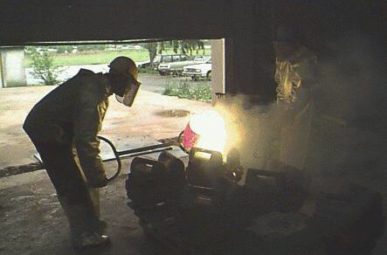Measurements and Terms
Please note that some of the included diagrams are quite large. This is to give you the highest level of detail. Please be patient when loading. These images were all taken from the book, “150 Years of Builders´ Hardware“
The Chas. Strelinger Co., of Detroit Michigan, was credited with the development of the method for figuring the hand of doors, according to an article in the November, 1886 issue of Carpentry and Building. The method was well received and became the standard used today.
Details Critical to Filling an Order for Door Hardware.
Before trying to place an order for door hardware, jot down a few details about the door and its hardware:
- Thickness of the door.
- Hand of the door and the locks.
- Width of the door and stiles where push and pull bars and kick plates are required.
- The type of strikes required for cremone bolts, surface bolts and casement fasteners.
- The type of lock front, whether flat, beveled or rabbeted.
- The backset of the locks.
- Sizes of the escutcheons, push plates, door pulls, etc. (Vertical dimensions first).
- If special strikes are needed, the length of the lip.
- Height of the door where cremone bolts are used.
- Length of casement adjusters, bolts, transom chains, transom lifters, etc.
- Special conditions that require actual details or drawings.
Diagrams
Common Door Construction Terms
Basic Door Measurements
Points from Which Locks are Measured
Taking Bit and Cylinder Lock Measurements
Details to Which Standard Hardware can be applied
Doors, Meetings, Stiles and Stops
Construction Details Impacting Hardware Selection
Types and Conditions of Bevel
Figuring Door Hardware
Hands of Distinctive Rim Locks
Identifying Lock Parts
Hand of Doors and Locks
Determining the Hand of Locks & Doors
The rules for handing were set down in the 1880s, giving the industry an established standard that had been sadly lacking. There are exceptions to the handing rules for specific cases. When needed, the hand of the door is also the hand of the lock and butt.
- The hand of a door is determined from the outside.
- The outside of an entrance door is the street side.
- The outside of a room door is the hall side.
- The outside of a closet door is the room side.
- The outside of a communicating door is the side where the butts cannot be seen when the door is closed.
- The outside of twin doors, either sliding or swinging, is the space between the two doors.
- Standing outside the door, if the butts are on the right it is a right hand door; if on the left it is a left hand door.
- When standing outside, if the door opens away from you, use a lock with a regular bevel latch bolt; if it opens toward you, use a lock with a reverse bevel latch bolt.
- Locks labeled “reversible” can be used on doors of either hand. However, if the door is beveled the hand and bevel of the door must be considered.
- The hand of French doors is taken from the inside when cremone bolts or casement fasteners are used.
- The inside of a French door is the side to which the cremone bolt is applied.
Fireplace Cranes
For ordering a fireplace crane, we need some measurements
Glossary
Glossary – Technical Terms as Applied to Builders’ Hardware
Acknowledgments:
We would like to sincerely thank Maud L. Eastwood for allowing us to use pages from her book, 150 Years Of Builders’ Hardware, Maud L. Eastwood, Copyright© 1993

